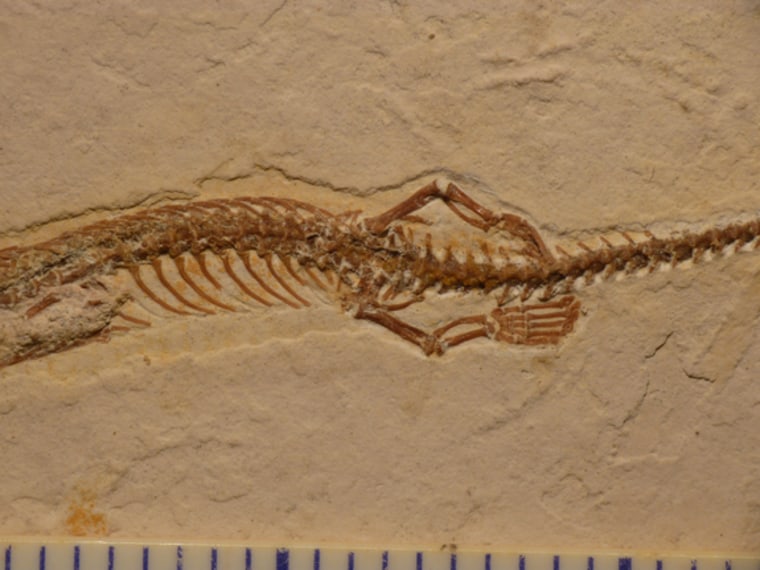The oldest snake fossil on record looks almost like a modern snake, except for one glaring difference: It has four feet, each with five digits, a new study finds.
The roughly 120-million-year-old snake, dubbed Tetrapodophis amplectus (literally, four-legged snake), likely didn't use its feet for walking. Instead, the appendages may have helped Tetrapodophis hold onto a partner while mating, or even grip unruly prey, said study co-researcher David Martill, a professor of paleobiology at the University of Portsmouth in the United Kingdom.

Previous research has detailed two-legged snake fossils, but this is the first known snake ancestor to sport four legs, he said. It likely evolved from terrestrial-burrowing creatures, and was a transitional animal that lived during the shift from ancient lizards to modern-day snakes, he added.
"We've found the ancestor of all snakes," Martill told Live Science. "We have found the missing link between four-legged lizards and snakes."
Martill happened upon the fossil during a field trip with his students to the Solnhofen Museum (formerly known as the Bürgermeister-Müller-Museum) in Germany. As they were looking at an exhibit of fossils from the Crato Formation, in northeastern Brazil, Martill noticed the 7.8-inch-long (20 centimeters) snake. It had a plaque that said "Unknown fossil."
"My jaw just dropped," he said. "I thought, 'Bloody hell, that's a fossil snake.'"
The Crato Formation happens to be one of Martill's prime subjects. He is the author of "The Crato Fossil Beds of Brazil: Window into an Ancient World" (Cambridge University Press, 2008), so he knew that a snake from the Crato Formation would be "about 20 million years older than any other fossil snake," he said.
Intrigued, he leaned in closer to the display to get a better look.
"I thought, 'Bloody hell, it's got back legs!'" Martill said. "It had front legs. Nobody had ever seen a snake before with four legs, and yet evolutionary theory predicts that there should be an animal that is transitional between four-legged lizards and snakes, and here it was."
His research was published Thursday in the journal Science.
Martill asked the museum if he could study the fossil, and recruited Helmut Tischlinger, a German paleontologist, and Nicholas Longrich, a senior lecturer in evolutionary biology at the University of Bath, to help him decipher the fossil.

The researchers found several indications that the fossil is, in fact, a transitional snake. Unlike lizards and crocodiles, Tetrapodophis has faint impressions of a single row of belly scales, a signature still seen on snakes today.
When the researchers used ultraviolet photography to examine Tetrapodophis' gut, they found partly digested bone fragments that the camera highlighted in different colors. These remnants suggest the snake ancestor ate vertebrates, just as modern carnivorous snakes do.
This is a condensed version of an article that appeared on Live Science. Read the original story here. Follow Laura Geggel on Twitter @LauraGeggel. Follow Live Science @livescience, Facebook & Google+.
MORE FROM LIVE SCIENCE